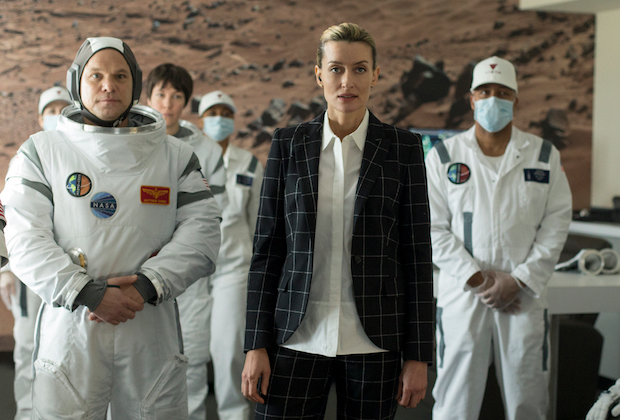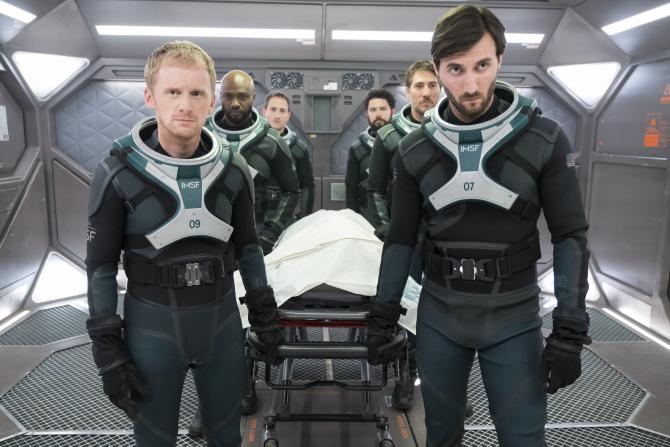Mars and The First: Can Fiction Help Ignite Exploration?
A look at National Geographic's Mars and Hulu's The First and what space exploration owes to fiction.
This story originally appeared in the Den of Geek special edition magazine.
In his 1959 short story “Out of the Cradle, Endlessly Orbiting,” Arthur C. Clarke imagined an astronaut who is present for some of the biggest moments in the history of space flight. It’s 2000, and in the last half century, the astronaut has witnessed the launch of the first satellite, the first man to orbit Earth, the first moon landing, the subsequent construction of a moon colony, and a miracle of life—the first child born outside of Earth.
Momentarily overlooking the triumphs of the lunar colony, Clarke’s protagonist still romanticizes the fourth rock from the sun. The Mars mission, he claims, would be man’s “first great leap” into space, leaving the moon as no more than “a suburb of Earth,” a stepping stone to the “places that really mattered.”
As a longtime member of the British Interplanetary Society, Clarke tried to write the future into existence. His fiction, which he’s best known for, was always infused with fact. In 1945, 12 years before the Soviet Union launched Sputnik, he proposed using space satellites for a global communication system. Whether he was writing about moon colonies or tirelessly crafting nonfiction books and magazine essays on the merits of space flight, Clarke’s work embodied a rich optimism, an inherent subtext that our species yearns to push further, higher, and beyond.
More than three decades after penning the short story, Clarke adjusted his expectations with a futurist’s decree: “I said [in “Endlessly Orbiting”] we would not really have conquered space until the first baby was born on the moon,” Clarke wrote in a 1992 Playboy essay. “Let’s change that locale to Mars and try, despite all the odds, to meet that 2015 target.”
A journey to Mars, and even a return to the moon for that matter, remains a moving target. The technology to put a human on Mars has been readily available for more than three decades, but a lack of funding has prevented any serious attempt. In 1992, Clarke was hopeful we could put a man on Mars by 2015. Expectations have shifted. Dreams of NASA planting a flag on Mars have given way to a space race in the private sector, led by Elon Musk and SpaceX, which is targeting a Mars mission by 2024. Government officials, scientists, private aerospace corporations, and journalists say Mars is the object in the mirror that is closer than it appears, but it’s worth questioning whether our ambition is trailing behind our imagination.
In many ways, popular culture–from recent blockbusters like The Martian to fantastical works like Total Recall, plus decades of sci-fi novels–has crystallized images of life on Mars for us. But does it render entry into the Martian atmosphere in real life little more than an inevitable formality in the eyes of the public? Have decades of science fiction writing and cinema desensitized us to the immense cost and manpower it will actually take to get to Mars, or is it the visual fuel we need to propel us toward innovation?
Recent works are hoping that marrying modern science with fiction will lend an authenticity to what would be mankind’s greatest adventure yet. Hulu’s new drama The First, from House of Cards showrunner Beau Willimon, is set in a near future where NASA has entered into a contract with a private corporation called Vista to develop and launch the first manned mission to Mars. Unlike most depictions of Mars missions, The First is primarily concerned with getting the rocket off the ground, and the toll that commitment takes on the astronauts and their families.
“There is a quite a sizable amount of work in the science fiction realm speculating and fantasizing about what space travel might look like in the far future,” Willimon says. “What you don’t see nearly as much of is: What does it look like within arm’s reach? Not a hundred years from now or a thousand years from now, but 10 years from now? It’s great to see images of what a colony would look like, but how do we get that first mission there and back? I think sometimes that’s avoided because that’s the really hard part where the rubber meets the road.”

Sean Penn stars as Tom Hagerty, one of the initial astronauts chosen for the mission. Amid clashes with Natascha McElhone’s Laz Engram, the CEO of Vista, Hagerty has to endure personal and professional strife to fulfill what he believes is his destiny. Willimon says the stories that he finds most compelling are ones where people go through harrowing sacrifice to achieve significant feats, and Mars is the biggest possible canvas for that story.
“It’s the latest iteration in an impulse among humans, that goes back millennia, of our insatiable desire to explore the unknown,” Willimon says.
Willimon’s research for the show led the creative team to what they felt was a realistic conclusion: It will take a public/private partnership to get a Mars mission across the finish line. Despite President Donald Trump signing a 2017 mandate for NASA to put astronauts on Mars by 2033, it’s widely believed that SpaceX will get there first. To do so, the company’s cooperation and collaboration with NASA will be key to the mission.
“There is no private sector company that has the half-century of experience that NASA has in terms of sending humans to space,” Willimon says. “There is a huge amount of research that is based upon real life missions of what it means to keep a human alive in space. To not draw upon NASA’s expertise and involve them in that aspect means that the private sector is having to start from scratch.”
In the show, the public/private partnership comes with intense legislative scrutiny and oversight. Hagerty and Engram spend scenes arguing the technological and aspirational reasons for why we should be spending the money and energy to make this interstellar trip a reality. While much of The First is centered on the human story, there are hard questions about allocating resources to such a risky mission, funds that could go a long way toward helping people on Earth.
“No mission in space happens without money, and that money doesn’t happen without popular will,” Willimon says. “Whenever you’re talking about popular will and political power, you’re also talking about a vast diversity of opinions on the value of space travel. We felt that was an important thing to touch upon.”
The glimpse into how a public/private partnership would operate in The First feels of our current moment. Willimon says seeing the fight to prove the Mars project’s value is a stage of the journey that hasn’t been fictionalized much in pop culture.
“We’re helping to complete the picture in showing what is near and close,” he says. “One of the goals of this show is that, in its own tiny way, it might have the ability to inspire people to get involved in space exploration, engineering, and science, and might push us a little closer to Mars.”
If The First is the micro view, the Why, then National Geographic’s MARS is the macro, the How. Based on the book How We’ll Live on Mars by Stephen Petranek, the show is a hybrid fictional story and documentary. In its first season, the drama begins with a ship entering Martian atmosphere while the documentary portion takes several steps back to examine the tremendous difficulty in safely landing a flight crew on the surface of Mars. It mirrors the opening of Petranek’s meticulously researched book, which starts with a prediction about the dream of a successful Mars mission before getting into the nuts and bolts: the history of planned Mars missions, the key players poised to make it there, and the challenges of actually living on the planet and transforming it to fit our human needs. It reads like a roadmap, much like how Clarke aspired to chart our celestial path one story at a time.
Peter Diamandis, co-founder of Planetary Resources, a commercial space exploration program with the goal of mining for vital resources in asteroids, says in the MARS season one finale, “There is a direct correlation between the dreams and the works of science fiction and reality. We as humans create the future we envision.” MARS is able to have it both ways by commentating on our present reality and using that information to devise a hyper-realistic depiction of a Martian colony.
“Not much science fiction actually correlates to future science fact, but there’s an exception: science fiction that relentlessly pursues a factual basis for its imaginings, science fiction like that proposed in the Nat Geo’s MARS series, is much more likely to foresee the future,” says Petranek, who serves as a co-executive producer and scientific advisor on the series.

MARS season two launches ahead to the next iteration of space travel. Once the initial group of astronauts and the next wave of settlers have an established the colony, the private sector sees Mars as the next profitable frontier. After a time jump, a company called Lukrum touches down with the intention of profiting off of the planet’s resources. Research versus profit becomes a sticking point between the Martian colonists.
Showrunner Dee Johnson questions via the series’ central conflicts whether we’re destined to make the same mistakes on Mars that we did on Earth.
“This was the ultimate new frontier,” Johnson says. “Are we doomed to repeat the same mistakes of explorers of the past where you exploit versus explore? That’s going back to the battle for the soul of the planet, because I would like to think that we wouldn’t make the same mistakes.”
The fictional drama of MARS touches on loss, political controversy, and internal and external conflict. It’s those themes that are central to the space epics that have become critical darlings: films such as Apollo 13 (directed by MARS executive producer Ron Howard), The Martian, Interstellar, Gravity, and now Damien Chazelle’s Neil Armstrong bio-pic First Man.
“[MARS] contributes to the literature of what can go wrong,” Peternak says. “People at NASA and SpaceX cannot assume they’ll think of everything—they actually need input from science fiction, especially when it’s based on fact.”
Says Willimon of grounding The First in cold, hard reality: “Let’s be brutally honest about how difficult this is and, at times, even how unglamorous it is, and that will really lend an authenticity to it feeling real and feeling near.”
NASA history is deeply embedded in the DNA of blockbuster films and shows like The First and MARS. The unshakeable sense of loss from national tragedies like the Challenger and Columbia flights is a sobering reminder that nothing is guaranteed when it comes to space travel. The Apollo 13 flight, which was originally destined to be a moon landing, turned into a rescue mission, and ultimately spooked an apprehensive Richard Nixon administration on investing in missions outside of the Earth’s orbit. It likely robbed a generation of the chance to see a human walk on Mars.
It’s critical that space programs learn quickly from past mistakes. Both The First and MARS are explicit in assuring that failure and loss cannot derail our hunger for exploration.
“The technology has been there for a long, long time,” Petranek says. “It’s a matter of money and commitment.”
While private companies draw the ire of scientists in MARS season two, the first season paints Elon Musk and SpaceX as the heroes poised to make it to Mars. Petranek was able to secure access to Elon Musk for How We’ll Live on Mars and National Geographic went behind-the-scenes with SpaceX for MARS season one. “It seems like we should have gone there by now, that’s what everyone expected,” Musk says in the season one finale. “We just kind of lost our way, but now we’re going to get back there.”
In the final moments of the MARS season one finale, SpaceX completes a successful vertical landing of its Falcon 9 rocket, a major milestone in the company’s goal to create reusable rockets for its Mars missions. The moment is all the more euphoric inside SpaceX since two previous attempts at a vertical landing had failed.
“Failures lead to more successes than a stream of successes themselves,” Petranek says. “We learn how to predict and fix potential disasters by having things go wrong along the way. The secret sauce in pursuing success is not to give up, to persevere and maintain a determination to succeed no matter how many failures there are.”
Patrenek sees value in science fiction–in particular the drama at the crux of The Martian, Interstellar, and Gravity–foreseeing “difficulty, trouble, and failure before success.”
What initially triggered his interest in space travel was an illustrated book he received as a child in the 1950s that portrayed a similar design to what was eventually the Lunar Excursion Module (LEM), years before the LEM was actually designed. The fiction helped him to dream of mankind reaching distant worlds, but it was factual achievements, the Mercury and Apollo Missions, that convinced him we could “accomplish anything in space we put our hearts and resources into.”
“Few people know this, but President [John F.] Kennedy apparently asked NASA to go to Mars, not the moon,” Petranek says. “NASA demurred and said it was more likely to get to the moon.”
Science fiction could once again help us regain the ambition to leapfrog the moon. For years it has been our escapism, but it can also be a window into the future. Perhaps shows like The First and MARS, or any to come from now until touch down on the Red Planet, will be seen as, to borrow a line from Clarke, “the great landmarks on the road to space.”
The First is now streaming on Hulu. National Geographic’s MARS season two premieres Nov. 12 at 9 p.m.
Read and download the Den of Geek NYCC 2018 Special Edition Magazine right here!
